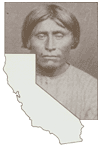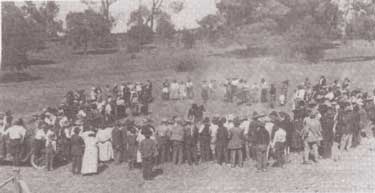![]()

Five Views: An Ethnic Historic Site Survey for California
MENU
Introduction
pre-1769
1769-1848
1849-1879
1880-1904
1905-1933
1934-1964
1965-1980
Historic Sites
Selected References

A History of American Indians in California:
HISTORIC SITES
Place Where They Burnt the Digger
Amador County
Place Where They Burnt the Digger is a Miwok Indian ceremonial area located on Old Stockton Road east of Highway 88 near lone, California. The site consists of approximately four acres of oak, manzanita, and pines, on top of a small hill above the road. Prior to 1920, a round house, about 40 feet in diameter, was constructed here. Four large poles and eight smaller poles in two circular patterns supported a roof made of dirt mixed with clay and wild grasses; 100 poles extended from the center of the house, forming a dome-like structure. In 1942, on the death of Dance Captain Charlie Maximo, the round house was destroyed.
In April 1922, the Miwok Indians of the Jackson Valley held a "Big Time," which is a gathering of all Indian people in the area for social or ceremonial reasons. This particular Big Time attracted many Indians from the surrounding region, especially from the lone, Tuolumne, and Jackson areas. On April 20, a dummy, made of old clothes and stuffed with straw, was burned as an effigy for the name "Digger." Prior to the burning of the Digger, the Miwok Indians, also called Mewuk and Mewok, had been named Digger Indians by the federal government. The following statement, issued to the Sacramento Agency by the Commissioner of Indian Affairs, appeared in the California Indian Herald:
Indians Score Victory After Government Eliminates Name Digger From Official Use
Hereafter the term "Digger" as representing the name of a tribe of Indians in the Sacramento jurisdiction, and appearing in the records of this Bureau, will be discontinued, objections having come from others that this term is one of contempt and regarded by the Indians as humiliating and opprobrius. It will, therefore, be replaced by the name 'Mewuk' which, upon accepted ethnological authority, is the true tribal designation of these Indians.
The change from "Digger" Indians to Mewuk, Mewok, or Miwok was the result of an appeal made by the Indian Board of Co-operation and nine of its delegates. Today, the Place Where They Burnt the Digger is important to the Miwok in two respects: first, it represents official recognition of the Miwok Indians and their cultural tradition; and second, since the time of the burning, the Indians of the area refer to themselves as Miwoks, and do not call themselves by their village names. (California Indian Herald, 1922:14)

Place Where They Burnt the Digger
NEXT> Quechla
Last Modified: Wed, Nov 17 2004 10:00:00 pm PDT
5views/5views1h65.htm
 Top
Top